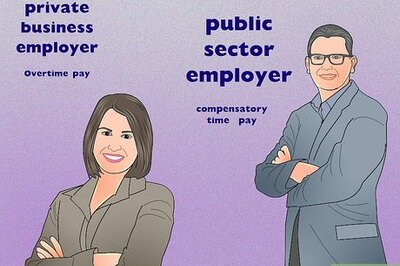
views
Mumbai: Faced with slowing economic growth and a dangerously high balance of payments deficit, about the last thing India needs is food prices pushing inflation higher, but that is just what the weather gods are brewing.
Rains have been patchy since the start of the monsoon season, which runs from June to September, and there are nagging fears of an El Nino weather pattern - which means less rainfall in South Asia - developing before the end of the year.
That spells higher prices for staple foodstuffs, where upward pressures are already evident, and a drag on growth, now running at its slowest in a decade, for an economy whose farm sector accounts for 15 percent of GDP.
"The deficit in rainfall will definitely cause food inflation to go up," said Arun Singh, senior economist at Dun & Bradstreet. "The extent of the impact will be known only after the monsoon is over."
The Reserve Bank of India is under pressure to give the economy a boost, but has resisted a growing clamour to reduce interest rates, due to worries over inflation partly fuelled by a weak rupee, which is down 4 percent against the dollar this year.
Wholesale price inflation, the measure watched most closely by the RBI, was running at 7.52 percent year-on-year in June. The food component, which has a 14-percent weighting in the index, showed an annual increase of 10.81 percent, up from 10.74 percent in May.
FALLING SHORT OF DEMAND?
Struggling to correct one problem in the economy without making another problem worse, Indian policymakers must regard the coming months with dread.
For India, the annual monsoon rains are crucial for farm output and economic growth, as about 55 percent of the country's arable land is rain-fed. The farm sector accounts for about 15 percent of the nearly $2-trillion economy, but about half of India's 1.2 billion people making a living from farming-related activities.
Almost halfway through the monsoon season, rainfall is 22 percent below average, and in some areas the rainfall deficit is as high as 68 percent.
Thankfully, recent bumper harvests mean India has record stocks of wheat and rice.
The worry lies in the output of pulses, edible oils, milk, poultry products, sugar, fruit and vegetables failing to keep up with rising demand.
Soyoil has risen over 11 percent in 2012 to hit a record high last week and its price is likely to rise further on tight supplies in the world market, raising the prospect that India will import more palm oil from Malaysia and Indonesia.
Poor rainfall has hit sugar cane production in Maharashtra and Karnataka, and the price on the local market has reached an 18-month high.
Lentils and beans make up a big part of the average Indian's diet, and the price of chickpeas, or chana as they are known locally, hit record highs last week.
The price of potatoes - India's most widely-consumed vegetable - has more than doubled since the start of the year.
And even India's favourite drink, tea, hasn't escaped, as bad weather and flooding in Assam state has cut production, pushing up prices more than 30 percent on year.
The poultry and dairy industries are preparing to raise the prices of milk, eggs and meat as corn and oilmeal prices have hit record highs, tracking a rally in overseas markets.
Many people in rural areas are so poor that they earn less than 26 rupees (47 cents) per day - which wouldn't buy even half a kilo of tomatoes at current prices.
Food has nearly a 50 percent weighting in the consumer price index, and is a highly sensitive issue politically, in a country where roughly one third of the 1.2 billion population lives in poverty.
Prime Minister Manmohan Singh's Congress Party doesn't face a national election until 2014, and while investors have judged his coalition government's performance negatively in financial markets, it is Indians in the bazaar who matter in terms of votes.
"Price is deciding what we are going to cook," housewife Alka Salunke said as shopped at a vegetable stall in central Mumbai. "I am avoiding expensive vegetables, but I have few choices."




















Comments
0 comment